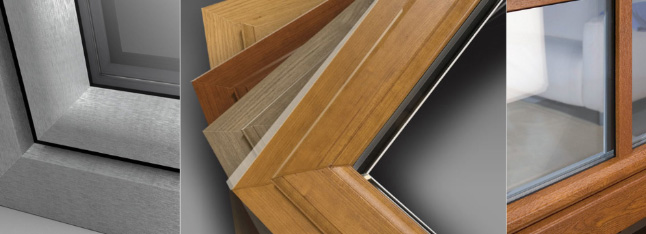
Adding a contemporary touch to the traditional uPVC windows, ECUBE WINDOORS announces the launch of its colored uPVC window profiles. Now mix and match up colors that go well with your wall color by choosing from an array of options ranging from solid colors to wood grain finishes such as Blue, Green, Grey, Red, Yellow � Ochre, Golden Oak, Mahogany, Rustic Oak, Teak and Walnut finishes.
The colored film on the uPVC profile surface has the following benefits.
This is an effort by the brand to offer consumers a wide range of choice in rejuvenating living spaces.

Windows and doors are one of the most integral part of any infrastructure and a medium through which light, sound and air is passed. Windows and doors instantly add on to the look of any building and are given significant attention when constructing a new building. To maintain a balance of heat and cold inside the building with the outside temperature, right windows and doors have to be chosen. Education institutions are one of the major users of windows and doors. Premier education institutions opt for windows and doors that are trend setters as well as affordable and durable in the long run.
Type of Windows and Doors suited for education institutions
High quality and energy efficiency are the key qualities to look for windows to be installed in education institutions. With the requirement for greater insulation and heat conservation, private buildings install windows that are energy efficient. Ground floor opening windows that are large enough to permit entry should be fitted with opening limiters as well as key operated locks. All windows facing accessible areas by anyone, should be fitted with laminated glass if they are less than 2.4 m from ground level. It is however generally recommended that all ground floor windows and other easily accessible windows are fitted with laminated glass. The use of robust restrictor devices is also recommended to opening windows, limiting the openings to a maximum of 100 mm. If necessary, attack resistant glazing in key locations can also be installed.
Interiors of the institutes can use windows that are internally beaded with aluminium or uPVC frames, but for security reasons, it is important to ensure that frames are adequately secured to the building fabric and the opening areas are secured by multi-point locking. In areas where levels of malicious damage and glass breakage may be high, external motorized steel security shutters may be considered necessary.
When it comes to doors, durability is the key factor. Exit doors of any education institution must be secured by good quality locks. The locking mechanisms are to be a minimum of five levers. Alternatively, locks should be at least 6 pin cylinder mechanisms, with anti-drill inserts. It is important that all external doors and their frames are installed using material of good standard. The frames should be securely fixed to the surrounding construction.
ECUBE WINDOORS � Expert in offering Windows and Door solutions to education institutions
ECUBE WINDOORS offers an expanded range of product lines such as uPVC window systems, Pre-finished wooden doors, Aluminium window systems and Facade solutions. It provides end to end solutions for windows and doors, from designing, manufacturing to installation catering to the needs of the education institutions.
The recent installation of windows for one of its prestigious client CMR University, Bangalore that has a state-of-the-art infrastructure include windows covering an area of 6000 sq. ft at the University. 76 sliding uPVC windows with single glazing were installed at the sprawling infrastructure. ECUBE WINDOORS has also extended its window and door solutions to other educational institutes like Sri Ramachandra University, Mahatma Gandhi Medical College, Dhirajlal University, PSG College of Technology and National Institute of Technology, Rourkela.
Though uPVC requires minimal maintenance, it is suggested that following the below mentioned tips will improve the life of your uPVC windows.

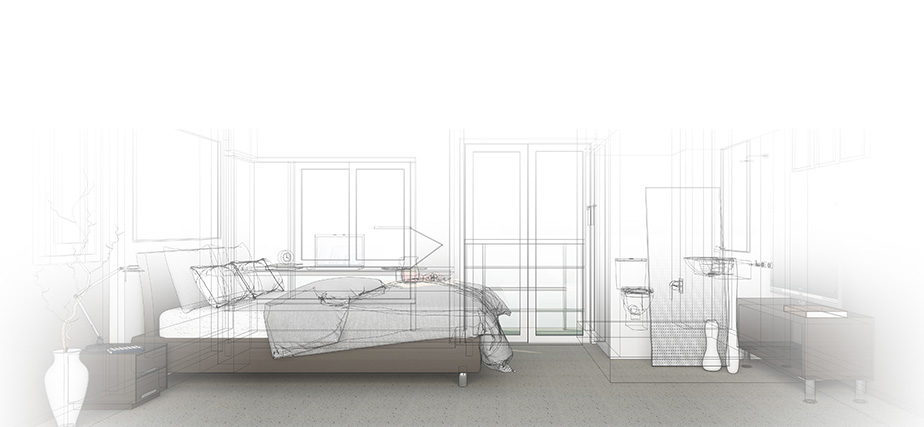
Well-ventilated indoor environments and access to natural light have proven to have improved health, comfort and productivity. However, windows also represent a major source of unwanted heat gain and discomfort. It is important that the specifying team take key parameters discussed in this article into consideration to avoid such problems.
Windows with frames made of uPVC dominate the window market, due to its ecological and economical advantages, as well as its functionality, design, easy care and safety. High-performance, energy-efficient uPVC window systems can dramatically cut energy consumption. They have superior thermal insulation properties and a strong wind load capacity that improve comfort. These high-performance uPVC windows feature double glazing, specialized transparent coatings that reflect UV light, insulating gas sealed between panes and improved frames. Thermal insulation is crucial in tropical regions as well as cold climatic regions, to ensure comfortable living conditions inside the dwelling while irrespective of exterior climatic conditions.
Accurate specification of uPVC window systems are essential for the energy efficiency of buildings. In a residential property, skin-load dominated structures (such as housing) optimum window design and glazing specification can reduce energy consumption from 10%-50% below the accepted practice in most climates.
To fully specify an uPVC window system, it is necessary to specify the following characteristics:
The heat transfer co efficient is often referred to as the U-value. This indicates the rate of heat flow due to conduction, convection and radiation through a window as a result of a temperature difference between the interior and exterior. It is expressed by the W/m2K value and determines the amount of existing thermal energy gained while it is transmitted through a building component with the size of 1 sq. metre within 1 second, assuming an air temperature difference of 1K between interior and exterior surfaces. The lower the U value, better the insulation qualities of the window.
In order to determine the heat transfer co efficient of the entire window, i.e. UW, add up the U values of the window frame (Uf), of the glazing (Ug) and the psi value of the glass edge sealing multiply it by their corresponding surface areas and length, respectively and divide the result through the surface area of the frame and glazing.
UW = ( Af * Uf + Ag * Ug + ? * Lg ) / ( Af + Ag )
Thermal energy gained/ lost in Watts ( W ) = UW * m2 * K where
UW is the thermal transmittance coefficient
m2 is the total surface area of the window in square metres
K is the difference between the indoor and the outdoor temperature in Kelvin
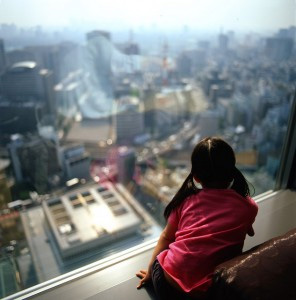
Selection of the right glass for your window makes all the difference by taking the parameters like heat insulation, sunlight, safety and security into consideration. Product performance is highly dependent on the choice of the glass that is being made.
Glass used in double glazing window for thermal insulation is known as Low E, or low-emissivity glass. It has a transparent metallic coating that works in two ways to economize heating energy. The dual action coating reflects heat back into the room, whilst allowing heat and light from the sun (known as passive solar heat gain) to pass through.
Reflective glass is that which has been coated with a metallic coating. The function of the coating is to reflect heat off the glass, rather than light. However, some reflective glass may also be coated such it has a very shiny finish and also reflects light off. The purpose of using reflective glass is to increase the energy efficiency of a place. It is especially suited to Indian climates, where it is warm for most of the year.
This refers to any glass that has been treated with a material such as a film or coating that reduces the transmission of light through it. Glass can be tinted with various types of coating, which block and/or reflect different amounts and types of light, according to the needs and preferences of the consumer.
Float glass gets its name from the modern process used to create large, thin, flat panels from molten glass. The molten glass is passed onto a pool of molten tin. This process produces a very smooth piece of glass with a highly consistent thickness.
Toughened, or tempered, glass is four to five times stronger than ordinary float glass. If it is broken relatively harmless fragments, known as �dice� are formed which are unlikely to cause injury. Toughened glass is made by heating prepared and processed glass sheets to a temperature of 700�C (just above the softening temperature of glass). The sheets are rapidly cooled by blasts of cold air to both surfaces, resulting in the outer surface contracting and solidifying before the interior of the glass. This process increases the tensile strength of the glass and gives it safe breakage characteristics
Annealed glass is a piece of float glass that has been cooled in a slow and controlled manner. This slow cooling process reduces the internal stresses within the sheet of glass so that it becomes stronger. Float glass is generally annealed and is the starting point for further treatment. Annealed glass will break into large and sharp shards or pieces. Due to safety concerns, annealed glass is rarely used in buildings.
Laminated glass is made by fusing two or more layers of glass with inter-layers of polyvinyl butyral (PVB) through the use of heat and pressure. The process creates a safety glass. Laminated glass is best used as a safety glass where the glazing must remain intact if it is broken � either for safety or security.
Heat strengthened glass is made from a sheet of annealed glass that is reheated beyond its annealing point of about 1200 degrees Fahrenheit and then cooled rapidly, but not as rapidly as tempered glass. Since it isn�t cooled as quickly, the compressive and tensile stresses aren�t quite equal across a section of glass. Therefore, the glass is only about twice as strong as annealed glass. Heat strengthened glass will break into smaller pieces than annealed glass, but these pieces may still be sharp and can cause injury. For this reason, heat strengthened glass is not considered to be safety glass.
Wire glass is generally thought to be stronger than annealed glass; however, this is not true. Wire glass is actually less strong than annealed glass because the integrated wire disrupts the continuity of the glass structure. Wire glass is not considered to be safety glass.
Wire glass is most often used as a fire resistant glass because the wire holds the glass in place if it shatters due to high heat. In addition, the wire holds the broken glass in place under pressure from a fire hose. Under high temperatures, the wire holds the glass in place better than the PVB films used in laminated glass.
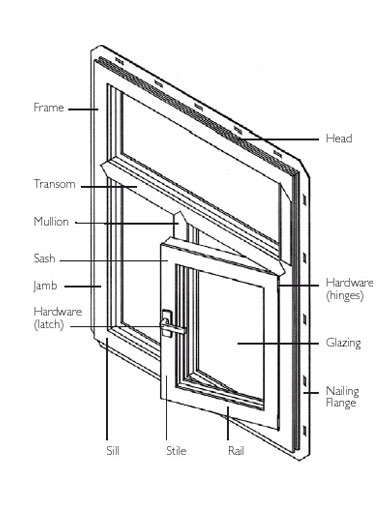
The basic components used in most uPVC windows are
Window profiles with a
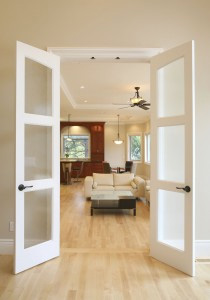
Here are some interesting insights on some of the basic interior & exterior door styles that are available today.
Hinged single door: This is the most common type. The room design must allow space for hinged doors to swing. Interior doors typically are lightweight and have two hinges; exterior doors are heavy and often use three hinges.
A flush door is a simple flat slab. It is usually the least expensive choice. If the surface is a hardwood veneer (usually birch or oak), a flush door can be stained, but other materials usually look best painted. Flush doors blend well with contemporary settings, but may look out of place in a traditional home. Interior flush doors are often hollow core, while exterior flush doors have a solid core and may have a metal or fiberglass face rather than wood veneer.
French doors add a charming touch as well as an extra-wide doorway opening. These doors are almost always traditional in design. Often they have glass panels. They are most commonly used as exterior patio doors, but interior French doors can make a stunning passageway between rooms.
A panel door is a classic style. It usually has three or four horizontal rails and three vertical stiles. The spaces between them are filled with thinner panels. Decorative molding (or some representation of it) called �sticking� surrounds each panel. The result is a richly textured look that is at home in both traditional and modern settings.
Patio sliding doors are typically made of large panes of glass encased in wood, vinyl or metal frames. They are the ideal choice when you want to maximize your view of the yard. Compared with French doors they take up no floor space when open. A possible disadvantage is that they only open half as wide as the doorway.
Pocket doors are a part of many older homes that have interior, which slide into the wall when fully opened. They allow you to completely open the doorway without taking up any floor space. Pocket doors are making a comeback; many styles are available such as single and double.
A security storm door can be locked to keep out intruders and may be heavier than a standard door. Self-storing storm doors have a window and screen. Inexpensive storm doors are often plain in design and can detract from the appearance of an entry door. You can pay more for a storm door that makes a design statement of its own, but perhaps the best choice is a storm door that unobtrusively frames your entry door.
A pair of bifold doors are a most popular choice for a closet that is 6 feet wider. Each door takes up about half the swinging space of a hinged door. Bifolds can be flush, paneled or louvered.

Various worksite employers will have management and control of the panels during the different phases of the installing a fa�ade system.
Prior to project commencement:
The designated site safety manager must visit the site; perform a full site safety inspection and verify if the site complies with the site safety plan, including but not limited to sidewalk sheds, fences, pedestrian protection, and protection of roofs and adjoining property.
Full-Time, Site Safety Oversight, which includes:
All employers should ensure, that people onsite and the public are not put at risk from glass panel handling.
The principal contractor should coordinate with the other site employers, including the panel installer, to ensure systems of work are developed to handle glass panels.
While installing fa�ade systems ensure the following:
Employers must provide information and any necessary training on the safe handling of the glass panels to all employees involved in the unloading, onsite storage or placement of the panels.Various worksite employers will have management and control of the panels during the different phases of the installing a fa�ade system.
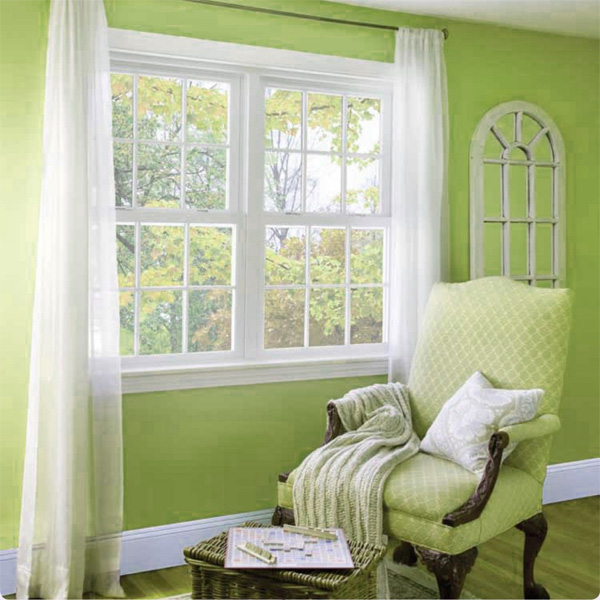
A little imagination can work wonders. Frame interesting pieces of fabrics to create a tapestry, add an elegant mirror on a narrow passage way to make it look double the size of that space, replace curtains with roman blinds to give your room a different look and feel.
Interesting ways to make up your windows
Drape Essentials: Traditionally, drapes project a formal, dramatic feel. But contemporary styles are more relaxed and can be attached to a rod with easy-to-assemble rings and clips. Drapes are a good option when you like changing window treatments with the seasons, too. Available in a variety of fabrics, you won�t have a problem finding warm, rich drapes for winter and lighter, airier versions for the summer.
Ensure care for outside too: Your window will look great on the inside, but don�t forget the view from the street. Consider painting the trim of your windows on the exterior of your home in a color that will complement the rest of your home. Windows on the first floor should be a good project you can do on your own, but get a professional to paint the window trim higher up.
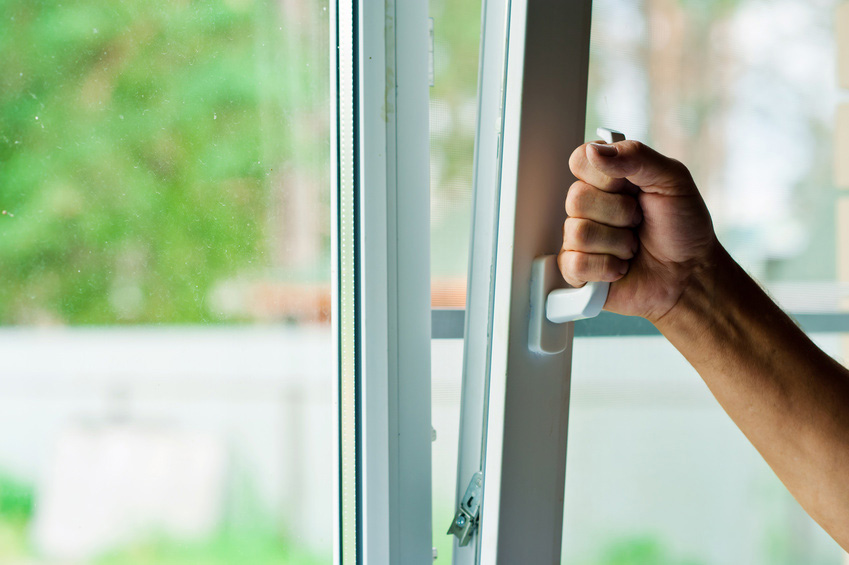
Here are a few signs to look out for to replace your uPVC window
1. Discoloration of the uPVC profileOver a long period time, inferior quality uPVC will begin to yellow and discolour. This can end up spoiling the aesthetics of your interiors. It can be easily fixed by replacing the window frame with a good quality uPVC window system.
2. Misted glassMisted glass is a sure sign that your double glazing isn�t effective. While many windows suffer from condensation on the exterior of the glass itself, misted glazing indicates condensation on the interior panes. It suggests that the perimeter edge seal is broken and is letting in moisture. Over a period of time, this can cause damage to the window and let the moisture into your property which in turn encourages the growth of mould and mildew.
3. Variation in temperature conditions within your interiors If your window is affecting the temperature of your room, it could be a sign that the frame or glazing is not proving to be effective. Various temperature conditions can impact the energy efficiency of your property, and even increase the costs of your electricity bills. An energy efficient uPVC window system would be the best solution for temperature control.



© Copyright 2023 - Ecube Windoors Pvt. Ltd, - All Rights Reserved.


